Hozzászóláshoz be kell jelentkezned
Szia, a karbit csak a szívócsonk tartja (3 imbuszcsavar) ? Legalábbis más rögzítést nem látok. Hétvége rászánva...
Mert nem a Kreidler F@ngotta a passzát szelet, hanem a nagyobb kutya!
Én támogatom!
Igen és adott lenne egy polgárháború.Mivel a másik 5 millió meg ellenük lenne.
A srác szerint elvileg fos ez a matrica. 

Pont ezt 12 EUR.t nem szántam már rá a matricákra...
egyébként nem értem hogy miért nem gyártottak tovább ilyeneket.. :S:S
ez kifejezeten teccik 

Első kép '67-es, többi '68-as.
The annual sprint meeting held at the Elvington airfield, did attract 50cc racers too. In 68 the Van Veen brought their latest sprinter hoping to break several records.
They did! Aalt Toersen broke three records :
The standing 1/4 were done in 15,568s at 57,8mph.
Standing kilometer : 30,318s at 73,8mph.
And standing mile : 44,39s at 81mph.
The bike shown with swingarm front- suspension were used for initial test on Zandvoort circuit
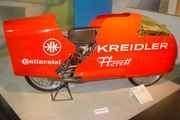
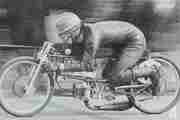
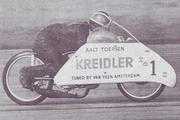
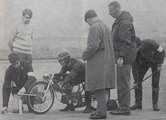
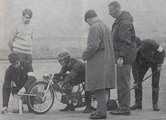
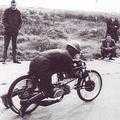
The annual sprint meeting held at the Elvington airfield, did attract 50cc racers too. In 68 the Van Veen brought their latest sprinter hoping to break several records.
They did! Aalt Toersen broke three records :
The standing 1/4 were done in 15,568s at 57,8mph.
Standing kilometer : 30,318s at 73,8mph.
And standing mile : 44,39s at 81mph.
The bike shown with swingarm front- suspension were used for initial test on Zandvoort circuit






És hogy örülj:
Utah, october 65
Learning from NSU, Kreidler returned with a very aerodynamic shaped vehicle, powered by a supercharged version of their dual- discvalved engine.
Driver Rudolf Kunz piloted the Vaifro Meo designed streamliner to eight new records at the Bonneville salt flats. The supercharged engine received a new handfull of ice, into the cylinder and head cooling cavity, before each take off.
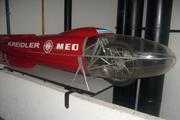
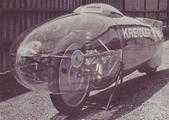

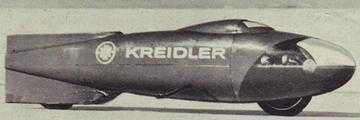
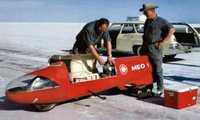
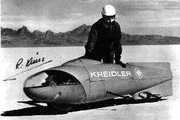
Utah, october 65
Learning from NSU, Kreidler returned with a very aerodynamic shaped vehicle, powered by a supercharged version of their dual- discvalved engine.
Driver Rudolf Kunz piloted the Vaifro Meo designed streamliner to eight new records at the Bonneville salt flats. The supercharged engine received a new handfull of ice, into the cylinder and head cooling cavity, before each take off.






Találtam burkolatlan képet a rekorder gépről:
There were of course other manufacturers who wanted a piece of the pie, and one of them was German Zündapp. During 1965 they built a special record breaker (see pics Zundapp1 and 2) and although the weather at Monza was not very good (why are so many record attempts so often plagued by bad weather?) during 12, 13, 14 and 15 May 1965, riders Andreas Brandl, Volker Kramer, Peter Eser, Günter Sengfelder, Heinrich Rosenbuch and Alfred Lehner broke the existing records.
The new records were as follows.
10 km : 153.452 km/h (old: 151.00 km/h) classes 50 and 75 cc
100 km : 162.002 km/h (old: 158.67 km/h) classes 50 and 75 cc
1000 km: 146.639 km/h (old: 117.02 km/h) classes 50 and 75 cc
1 hour : 162.609 km/h (old: 159.11 km/h) classes 50 and 75 cc
6 hours : 147.798 km/h (old: 139.49 km/h) classes 50 and 75 cc
12 hours: 137.039 km/h (old: 113.46 km/h) class 50 cc
(old: 114.00 km/h) class 75 cc
(old: 114.00 km/h) class 100 cc
(old: 133.00 km/h) class 125 cc
The engine was air cooled, and was developed from the trials bike, but was equipped with a rotating inlet disc and a five-speed gearbox, with an extra two-speed box behind it, operated from the left clip-on, just like the Kreidler racers, giving 10 speeds in total. Bore and stroke were 40 x 39.5 mm. Power was given as over 10 bhp at 11,000 rpm. Petrol with an octane number of 98 was used and lubrication oil was mixed with the petrol 1 : 25. The 18" wheels carried tyres specially made by Metzeler, which lasted the whole distance. Total weight was 82 kg. On 14 May Volker Kramer broke the records over 1 hour and 100 km. The engine used for this had water cooling and was slightly more powerful (500 rpm more). The fairing was closed for better streamlining - the radiator was cooled with a little, battery driven fan. Using the same engine, on 15 May Volker Kramer broke the record over 10 km.
J.Kortekaas 2006
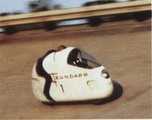
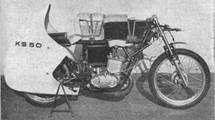
There were of course other manufacturers who wanted a piece of the pie, and one of them was German Zündapp. During 1965 they built a special record breaker (see pics Zundapp1 and 2) and although the weather at Monza was not very good (why are so many record attempts so often plagued by bad weather?) during 12, 13, 14 and 15 May 1965, riders Andreas Brandl, Volker Kramer, Peter Eser, Günter Sengfelder, Heinrich Rosenbuch and Alfred Lehner broke the existing records.
The new records were as follows.
10 km : 153.452 km/h (old: 151.00 km/h) classes 50 and 75 cc
100 km : 162.002 km/h (old: 158.67 km/h) classes 50 and 75 cc
1000 km: 146.639 km/h (old: 117.02 km/h) classes 50 and 75 cc
1 hour : 162.609 km/h (old: 159.11 km/h) classes 50 and 75 cc
6 hours : 147.798 km/h (old: 139.49 km/h) classes 50 and 75 cc
12 hours: 137.039 km/h (old: 113.46 km/h) class 50 cc
(old: 114.00 km/h) class 75 cc
(old: 114.00 km/h) class 100 cc
(old: 133.00 km/h) class 125 cc
The engine was air cooled, and was developed from the trials bike, but was equipped with a rotating inlet disc and a five-speed gearbox, with an extra two-speed box behind it, operated from the left clip-on, just like the Kreidler racers, giving 10 speeds in total. Bore and stroke were 40 x 39.5 mm. Power was given as over 10 bhp at 11,000 rpm. Petrol with an octane number of 98 was used and lubrication oil was mixed with the petrol 1 : 25. The 18" wheels carried tyres specially made by Metzeler, which lasted the whole distance. Total weight was 82 kg. On 14 May Volker Kramer broke the records over 1 hour and 100 km. The engine used for this had water cooling and was slightly more powerful (500 rpm more). The fairing was closed for better streamlining - the radiator was cooled with a little, battery driven fan. Using the same engine, on 15 May Volker Kramer broke the record over 10 km.
J.Kortekaas 2006


hát ja sajnos ez ellen semmi esélye semmiféle puchnak zündappnak sachsnak vagy akár kreidlernek... :S
oookéé :D semmi gond.

megyez 10 ezernél eladva
:D
:D
2005
2001
2000






























A karbi elején/tetején van a csavar.